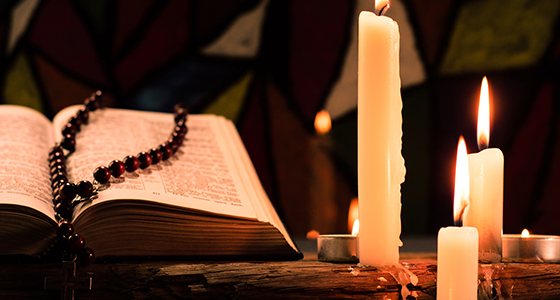The Bible’s Table of Contents

The clearest example of a sacred Tradition that both Catholics and Protestants accept is the canon of Scripture. The word canon comes from a Greek word that means “rule,” and refers to the Church’s official list of inspired writings. You can find this list in the table of contents of every Catholic or Protestant Bible.The canon of Scripture was first declared in Rome in A.D. 382and was later defined at two Catholic councils in North Africa(Hippo in A.D. 393 and Carthage in A.D. 397).
However, if you are a Christian who denies the authority of the Catholic Church, then by what authority can you say Christians must accept the canon of Scripture found in today’s Bibles?
Some say it’s just obvious the books of the Bible all belong there and we don’t need any Church to prove they do, but is it really so obvious? Paul’s letter to Philemon doesn’t teach any specific doctrine, and the third letter of John doesn’t even mention the name of Jesus Christ. Conversely, other writings that were popular in the early Church, like the Didache or the letter of Clement,are not in the canon of Scripture.
Others say“the church” (with a lowercase “c”) determined the canon, but we aren’t obligated to follow what any church might teach today. But if that group of early Christians did not have Christ’s authority, then we have no reason to continue following their doctrinal decisions, including their decisions about the canon. The Protestant theologian R.C. Sproul famously suggested that the best we can say is that the canon of Scripture is “a fallible list of infallible books.”This means any Christian who feels moved by the Holy Spirit could claim the table of contents in the Bible needs to be revised, or even that some portions of the Bible should be removed.
In fact, five hundred years ago Martin Luther and other Protestant Reformers did just that. Luther called the letter of James “an epistle of straw” because it contradicted his theology,so he moved it to the back of the Bible. Even though Luther and the other Reformers kept the letter of James, they removed books,called the deuterocanonicals, from the Old Testament. These books, like Sirach, Tobit, and Maccabees (among others), were part of the Bible Jesus used and were considered inspired Scripture in the early Church. One reason the Reformers rejected books was because they teach Catholic doctrines like the existence of purgatory and the need to pray for the dead.
Scripture, Tradition, and the Church
Catholics agree we should not believe anything that contradicts God’s word, in either its written form (the Bible) or its oral form (Tradition).
If an alleged tradition contradicts Scripture, then the tradition must be of human—small“t”—rather than divine—capital“T”—origin. But if a document that claims to be Scripture (such as a forged or heretical gospel) contradicts Sacred Tradition, then it too must be of human origin. God speaks through the written word, but as we’ve seen, only through Scared Tradition can we know which writings are the word of God and which ones are not.
Sacred Tradition also protects the Church from false interpretations of the Bible. My Protestant friends would sometimes debate other religious people who denied basic Christian doctrines like the deity of Christ.They’d point out Bible passages that they say proved Jesus is God, only to hear the other person say, “Yes, but that’s not how I interpret those passages.”I thought it was ironic when one of my Protestant friends said, “But my interpretation of these passages is the same one Christians have held for two thousand years!”
This was a perfect example of how God’s word speaks in Scripture through the written word (or what the Bible says), but also through oral Tradition (or teachings about what the Bible means). But whose tradition should we look to for guidance on interpreting the Bible?
My Protestant friends couldn’t even agree among themselves on what the Bible taught concerning issues like whether babies should be baptized or if your salvation can be lost. It’s no wonder that in his second letter St. Peter taught, “no prophecy of scripture is a matter of one’s own interpretation” (2 Pet. 1:20).
St. Vincent of Lerins
made this point in the fifth
century when he noticed that heretics could cite Scripture just as well as the
faithful. This meant that another authority was necessary to settle
disputes about what Christians should believe.
This
authority could be none other than the Church Christ founded, or,
as Vincent
wrote, “The
rule
for the right understanding of the prophets and apostles should
be framed in accordance with the standard of ecclesiastical and Catholic
interpretation.”
Did you enjoy this excerpt? Order your copy of Why We’re Catholic today for just $10 (Includes Shipping – US Only)
Recent Posts
-
Are We Superior to the Early Christians?
If the early Church was the Catholic Church, why can’t we say that Christians just lost their way ea …Jul 15th 2024 -
Did the Early Christians Get Things Wrong?
You can find countless variations of the claim that early Christians believed Protestant things: …Jul 1st 2024 -
How to Respond When the World Tells Us We Can "Build Our Own Deity"
The necessity of revelation and of knowing God on his terms is not accepted in our culture today. A …Jun 22nd 2024









